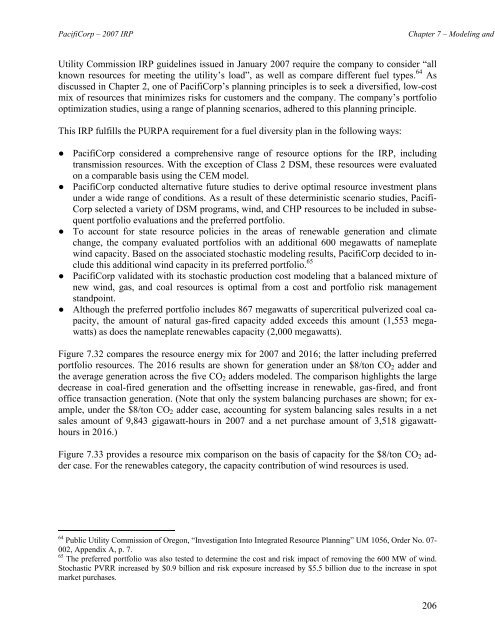PacifiCorp 2007 Integrated Resource Plan (May 30, 2007)
PacifiCorp 2007 Integrated Resource Plan (May 30, 2007)
PacifiCorp 2007 Integrated Resource Plan (May 30, 2007)
Create successful ePaper yourself
Turn your PDF publications into a flip-book with our unique Google optimized e-Paper software.
<strong>PacifiCorp</strong> – <strong>2007</strong> IRPChapter 7 – Modeling andUtility Commission IRP guidelines issued in January <strong>2007</strong> require the company to consider “allknown resources for meeting the utility’s load”, as well as compare different fuel types. 64 Asdiscussed in Chapter 2, one of <strong>PacifiCorp</strong>’s planning principles is to seek a diversified, low-costmix of resources that minimizes risks for customers and the company. The company’s portfoliooptimization studies, using a range of planning scenarios, adhered to this planning principle.This IRP fulfills the PURPA requirement for a fuel diversity plan in the following ways:● <strong>PacifiCorp</strong> considered a comprehensive range of resource options for the IRP, includingtransmission resources. With the exception of Class 2 DSM, these resources were evaluatedon a comparable basis using the CEM model.● <strong>PacifiCorp</strong> conducted alternative future studies to derive optimal resource investment plansunder a wide range of conditions. As a result of these deterministic scenario studies, Pacifi-Corp selected a variety of DSM programs, wind, and CHP resources to be included in subsequentportfolio evaluations and the preferred portfolio.● To account for state resource policies in the areas of renewable generation and climatechange, the company evaluated portfolios with an additional 600 megawatts of nameplatewind capacity. Based on the associated stochastic modeling results, <strong>PacifiCorp</strong> decided to includethis additional wind capacity in its preferred portfolio. 65● <strong>PacifiCorp</strong> validated with its stochastic production cost modeling that a balanced mixture ofnew wind, gas, and coal resources is optimal from a cost and portfolio risk managementstandpoint.● Although the preferred portfolio includes 867 megawatts of supercritical pulverized coal capacity,the amount of natural gas-fired capacity added exceeds this amount (1,553 megawatts)as does the nameplate renewables capacity (2,000 megawatts).Figure 7.32 compares the resource energy mix for <strong>2007</strong> and 2016; the latter including preferredportfolio resources. The 2016 results are shown for generation under an $8/ton CO 2 adder andthe average generation across the five CO 2 adders modeled. The comparison highlights the largedecrease in coal-fired generation and the offsetting increase in renewable, gas-fired, and frontoffice transaction generation. (Note that only the system balancing purchases are shown; for example,under the $8/ton CO 2 adder case, accounting for system balancing sales results in a netsales amount of 9,843 gigawatt-hours in <strong>2007</strong> and a net purchase amount of 3,518 gigawatthoursin 2016.)Figure 7.33 provides a resource mix comparison on the basis of capacity for the $8/ton CO 2 addercase. For the renewables category, the capacity contribution of wind resources is used.64 Public Utility Commission of Oregon, “Investigation Into <strong>Integrated</strong> <strong>Resource</strong> <strong>Plan</strong>ning” UM 1056, Order No. 07-002, Appendix A, p. 7.65 The preferred portfolio was also tested to determine the cost and risk impact of removing the 600 MW of wind.Stochastic PVRR increased by $0.9 billion and risk exposure increased by $5.5 billion due to the increase in spotmarket purchases.206
















